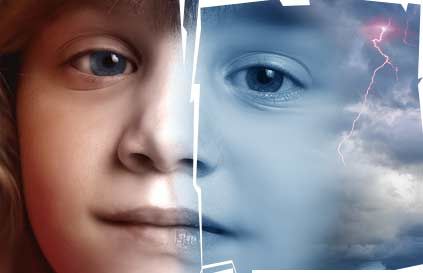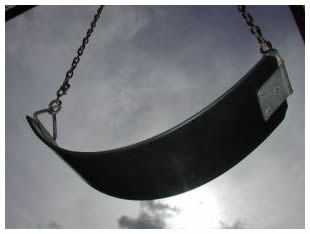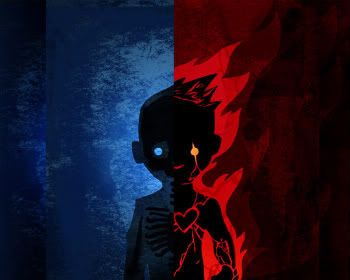This diary is basically a republishing of a paper I wrote awhile back. The original paper — written when I was 20 taking a graduate class in my undergraduate program — was over twice the length of what you’ll find below the fold. I trimmed it down and reused it for a paper at my current university, and that’s what you see here.
 I am sharing this diary about pediatric bipolar disorder (which is not listed separately from BD in the DSM) because I think most educated people have at least a rudimentary idea of what bipolar disorder is. Pediatric bipolar disorder is less talked about because it is less accepted and therefore more controversial. This makes sense for plenty of reasons. For one thing, the criteria being used to diagnose it are often different or fewer than those formally listed in the DSM. Many people believe that bipolar disorder never fully manifests until late adolescence or early adulthood, and will not accept a “pediatric” form of the disorder as being valid. Further, it is very controversial because of the generally accepted notion that bipolar disorder requires pharmacological intervention, and the medications used to treat it can cause a plethora of adverse cognitive and physiological side effects. The idea of giving these medications to children in their formative years is disturbing to many (including myself, due to intimate personal understanding of how dangerous these medications can be even for adults). Then, of course, there is the argument that bipolar disorder may be over-diagnosed, and that to label a child with such a debilitating, chronic illness is inappropriate.
I am sharing this diary about pediatric bipolar disorder (which is not listed separately from BD in the DSM) because I think most educated people have at least a rudimentary idea of what bipolar disorder is. Pediatric bipolar disorder is less talked about because it is less accepted and therefore more controversial. This makes sense for plenty of reasons. For one thing, the criteria being used to diagnose it are often different or fewer than those formally listed in the DSM. Many people believe that bipolar disorder never fully manifests until late adolescence or early adulthood, and will not accept a “pediatric” form of the disorder as being valid. Further, it is very controversial because of the generally accepted notion that bipolar disorder requires pharmacological intervention, and the medications used to treat it can cause a plethora of adverse cognitive and physiological side effects. The idea of giving these medications to children in their formative years is disturbing to many (including myself, due to intimate personal understanding of how dangerous these medications can be even for adults). Then, of course, there is the argument that bipolar disorder may be over-diagnosed, and that to label a child with such a debilitating, chronic illness is inappropriate.
I have my misgivings about the way bipolar disorder is diagnosed in children, but after years of off-and-on study of the topic, I have come to the conclusion that the early manifestation of the disorder is, though rare, a reality. I also have doubts about the degree of “rapid cycling” described by some authors in the field. Still, it makes for intriguing reading. If you have a few free minutes, follow me below the fold for a review of the current literature.
There is substantial evidence for the existence of bipolar disorder in children, and children who suffer from pediatric bipolar disorder (PBD) may face worse prognoses than bipolar adults. It is therefore important that this condition be diagnosed as early as possible so that measures can be taken to prevent the disorder from progressing and interfering with the child’s development. Unfortunately, the comorbidity of pediatric bipolar disorder with other disorders — particularly attention deficit hyperactivity disorder and conduct disorders — complicates the process of reaching an accurate diagnosis. The differences between early-onset and adult-onset bipolar disorder raise questions of whether the criteria listed in the DSM-IV-TR can appropriately guide clinicians in their attempts to diagnose and treat children suffering from the disorder. Much of the research on PBD is contradictory, inadequate, or inconclusive, but enough seemingly accurate information is currently available to suggest appropriate diagnostic measures and treatment options.
It is important to have an understanding of the discrepancies in presenting symptoms which differentiate child- from adult-onset bipolar disorder. It has been well documented that,
Whereas the adult-onset forms of bipolar-spectrum illnesses are characterized by distinct, lengthy mood states and inter-episode recovery, initial data suggest that adolescents who have bipolar spectrum disorder suffer from an illness characterized by brief mood episodes, rapid cycling, mixed states and an absence of inter-episode recovery. (Findling, Gracious, McNamara, Youngstrom, Demeter, Branicky, & Calabrese, 2001, p. 202)
 This tendency toward rapidly changing moods is one of the distinguishing features of pediatric bipolar disorder. Kim and Miklowitz illustrate the statistical differences of mixed episodes between early-onset versus adult-onset bipolar disorder by examining two studies, reporting that, “Wozniak et al. found that 84% of a referred prepubertal sample of bipolar children showed a chronic history of mixed states,” whereas McElroy et al. “estimated that only 30% of adults . . . present for treatment with mixed episodes” (2002, p. 216).
This tendency toward rapidly changing moods is one of the distinguishing features of pediatric bipolar disorder. Kim and Miklowitz illustrate the statistical differences of mixed episodes between early-onset versus adult-onset bipolar disorder by examining two studies, reporting that, “Wozniak et al. found that 84% of a referred prepubertal sample of bipolar children showed a chronic history of mixed states,” whereas McElroy et al. “estimated that only 30% of adults . . . present for treatment with mixed episodes” (2002, p. 216).
The rate of cycling is another distinguishing factor between the two onset types. Rapid cycling, which is one of the most severe forms of bipolar disorder in adults, is almost universal among children. Because such cycling is seen far less often in adults, Craney and Geller attempt to clarify the different types by defining them: “the definition of rapid cycling was four episodes per year. Ultrarapid cycling was defined as 5-364 per year, and ultradian (continuous) rapid cycling was [over 364] per year. . . . In ultradian cycling, mania needed to occur for [more than] 4 h/day” (2003, p. 248). One sample typifies the cyclic characteristics presenting in early-onset bipolar disorder: “. . .no PEA-BP subject had only four episodes per year. Rather, continuous (ultradian) rapid cycling was the most prevalent pattern (77.4%)” (p. 250-251). Craney and Geller further assert that, these young children had the characteristics of the most severely ill adults with BP [e.g., mixed mania, continuous (ultradian) rapid cycling, psychosis, treatment resistance]” (p. 255). Assuming that this information is correct, it is clear that accurate diagnosis and immediate intervention are necessary for these children; unfortunately, a rush to diagnose PBD — even if it is warranted — may not be palatable to most mental health professionals. To the typical clinician, who may be more accustomed to treating adults, the concept of ultrarapid and ultradian cycling may seem almost inconceivable; still more difficult to believe is that ultradian cycling is the rule rather than the exception. Many clinicians and researchers are highly skeptical of such findings. It is difficult to associate such an extreme course with even the most severe cases of “classic” bipolar disorder, and the radically different symptoms found in PBD may prove confusing. Some researchers warn against the strict application of adult criteria to children:
. . .continued application of seemingly arbitrary episode-duration criteria developed for adult BD, and the basic assumption that BD always presents as discrete, sustained episodes with relatively euthymic intervals surely limit consideration of BD in young patients. In contrast to adult BD, in early onset BD mixed-dysphoric and labile, rapidly changing presentations are common. Discrete episodes may not be recognized, or the condition may be considered a form of ‘ultra-rapid’ cycling (URC). (Faedda, Baldessarini, Glovinsky, & Austin, 2004, p. 306)
 Perhaps a modification of the current criteria as they apply to children should be considered, but it is difficult to ascertain exactly which criteria are arbitrary. Extensive research and clinical studies would need to be undertaken in order to determine which symptoms should be included as diagnostic criteria. At this point in time, it may be impossible — as well as imprudent — to begin revamping the qualifying factors for the disorder.
Perhaps a modification of the current criteria as they apply to children should be considered, but it is difficult to ascertain exactly which criteria are arbitrary. Extensive research and clinical studies would need to be undertaken in order to determine which symptoms should be included as diagnostic criteria. At this point in time, it may be impossible — as well as imprudent — to begin revamping the qualifying factors for the disorder.
Researchers have generally found irritability to be a consistent and universal characteristic of PBD. Whereas adults do not always consistently present with this symptom, “irritability (without elation) has been described as if it were pathognomonic of child-onset mania” (Craney & Geller, p. 244). McIntosh and Trotter observe that, “Unlike adults with BPD, children with mania typically do not manifest euphoria, but severe irritability” (2006, p. 452). Findling et al. note that
“Some have suggested that children who meet diagnostic criteria for mania may be chronically irritable and dysphoric . . . others have questioned whether these pervasively irritable youths suffer from bipolar disorder” (2001, p. 203). It is likely that irritability is a poor marker, as it is “a formal diagnostic criterion in depression, mania, posttraumatic stress disorder, oppositional defiant disorder, adjustment disorder, and intermittent explosive disorder, and is a common associated feature in a wide variety of other disorders” (Youngstrom, Findling, Youngstrom, & Calabrese, 2005, p. 437). Because irritability is far from unique to any mood disorder, the argument that the presence of this symptom is sufficient to diagnose any mental illness is misguided. While irritability may be the cardinal symptom of PBD, its presence in the absence of other symptoms common to BD is not adequate to justify diagnosing this disorder in a child.
With such extreme differences between adult-and child-onset bipolar disorder, it is not unreasonable to propose that these manifestations represent separate mental illnesses. Carlson describes the bipolar controversy:
. . . [it] is about what a broader definition of mania with less clear-cut episodes and more childhood psychopathology and concurrent comorbidity represents: (a) a developmentally altered condition (the implication being that it will change in adulthood), (b) an earlier and thus more severe rendition with a worse prognosis (somewhat like childhood schizophrenia is to adult schizophrenia), (c) a subtype of bipolar disorder or related condition (e.g., continuous with adult mixed and rapid cycling), or (d) a temperamental, genetically related construct (e.g., hyperthymic temperament) that is stable and may or may not predict bipolar disorder. (2005, p. 335)
Because of the confusion over these issues, The National Institute of Mental Health (NiMH) has “recommended the use of ‘bipolar disorder not otherwise specified’ (BP-NOS) as a working diagnosis for children who show manic symptoms primarily of irritability and aggression — but do not meet DSM-IV criteria for bipolar I or bipolar II disorder” (Kim & Miklowitz, p. 216). The use of the BP-NOS label recognizes PBD as a subtype of BD, but it does not require that it imitates the traditional form of BP-I.
 Perhaps the single most difficult aspect of diagnosing PBD is the high rate of comorbidity found in children and adolescents with early-onset bipolar disorder. ADHD and conduct disorders are frequently comorbid with PBD. In one sample, Youngstrom et al. reported that “most of [the] youths (83.9 % of children, 76.5% of teenagers, 81.1% overall) met diagnostic criteria for a comorbid condition while euthymic. . . . Attention deficit hyperactivity disorder (ADHD) was the most common comorbidity. It was found in 70.0% of the youths” (p. 436). Conversely, ADHD “is usually not even reported as a comorbidity in manic adults (Craney & Geller, p. 244). It may be difficult to conclude that two such vastly different presentations are both suitably described by a single category. According to Kim and Miklowitz, this comorbidity “raises questions about the bipolar diagnosis in younger samples” (p. 217). In order to differentiate these two disorders and prevent misdiagnosing children, it is important to search for alternative methods of assessing them.
Perhaps the single most difficult aspect of diagnosing PBD is the high rate of comorbidity found in children and adolescents with early-onset bipolar disorder. ADHD and conduct disorders are frequently comorbid with PBD. In one sample, Youngstrom et al. reported that “most of [the] youths (83.9 % of children, 76.5% of teenagers, 81.1% overall) met diagnostic criteria for a comorbid condition while euthymic. . . . Attention deficit hyperactivity disorder (ADHD) was the most common comorbidity. It was found in 70.0% of the youths” (p. 436). Conversely, ADHD “is usually not even reported as a comorbidity in manic adults (Craney & Geller, p. 244). It may be difficult to conclude that two such vastly different presentations are both suitably described by a single category. According to Kim and Miklowitz, this comorbidity “raises questions about the bipolar diagnosis in younger samples” (p. 217). In order to differentiate these two disorders and prevent misdiagnosing children, it is important to search for alternative methods of assessing them.
A number of methods to aid in the diagnosis of PBD have been proposed. Such methods include looking for “(a) ‘handle symptoms,’ or symptoms that . . . are relatively specific to the condition; (b) evidence of cycling or distinct spontaneous changes in mood functioning; and (c) extending the window of assessment beyond a single diagnostic interview” (Youngstrom et al., p. 428). Searching for the symptoms unique to bipolar disorder may aid clinicians in their task of sifting through the wide range of comorbid symptoms that often present alongside BD in children. These unique symptoms include “elevated mood, grandiosity, pressured speech, racing thoughts, and hypersexuality. . . . [one] operational definition of prepubescent and early adolescent bipolar disorder requires the presence of either elevated mood or grandiosity plus at least three other manic symptoms to classify a child as manic” (p. 438). Such symptoms are characteristic of “classic” forms of adult mania, and their presence is a strong indicator of BD in children. Kim and Miklowitz, however, point out that “euphoria and grandiosity . . . are relatively rare in bipolar children” (p. 217). Nevertheless, the search for cycling of moods could be useful because children with ADHD and/or disruptive behavior patterns are not typical of any form of bipolar disorder. Extending the window of assessment may ensure a more accurate diagnosis because a mental health professional will be able to track a child’s symptoms over time, which may uncover important information about mood fluctuations which might have been missed during the initial assessment.
One especially dismal feature of PBD is the increased risk of suicide. It is estimated that approximately 19% of adults with bipolar disorder will commit suicide, and the number of people who will make one or more unsuccessful attempts is much higher. Having early-onset bipolar disorder seems to increase the likelihood that these youths will eventually attempt suicide. Several important risk factors have been indicated:
. . . pediatric bipolar patients at highest risk for suicide attempt include those who are older, with a lifetime history of mixed episodes, psychotic features, and BPI, comorbid substance use, history of hospitalization, and history of physical and/or sexual abuse. (Goldstein, Birmaher, Axelson, Ryan, Strober, Gill, Valeri, Chiappetta, Leonard, Hunt, Bridge, Brent, & Keller, 2005, p. 533)
A greater number of risk factors increased the probability that a patient will attempt suicide. A diagnosis of a comorbid behavior disorder or anxiety disorder, however, did not increase the risk of suicide, and PBD patients who were comorbid with ADHD were less likely to commit suicide (p. 530). This information about the heightened risk of suicides elucidates the importance of early detection and treatment of PBD.
Innumerable theories about the etiology of bipolar disorder have been posited. The heritability of all forms of affective disorders has been extensively researched, and strong biological markers have been indicated for the development of these disorders. It is a well-accepted fact that having a bipolar relative, especially a parent, increases the probability that a child will develop BD. It has been estimated that “The odds ratio for risk of bipolar disorder in youths with a bipolar biological parent ranged from 2 to 10, with an average of 5” (Youngstrom et al., p. 436). Some reports indicate that “youths at genetic risk experience more severe hypomanic and manic symptoms than others” (Findling, Youngstrom, McNamara, Stansbrey, Demeter, Bedoya, Kahana, & Calabrese, 2005, p. 629). Though statistics vary, all studies indicate a significantly increased risk of developing BD for individuals whose relatives have been diagnosed with the disorder; this increased risk, however, does not necessarily mean that individuals with bipolar parents will usually (or even often) manifest the disorder. In fact, children with bipolar parents have a greater chance of developing a wide variety of other disorders. Faedda et al. reported that children with bipolar parents “are found to have increased risks of various forms of psychopathology (affective, anxiety and behavioral disorders, or substance abuse), but the diagnosis of BD itself has been uncommon” (p. 306). Even in children of bipolar parents who do not express BD, “Jaenicke et al. found that . . . the offspring of BD mothers had a less positive self concept, a more negative attributional style, and less positive (though not more negative) recall of words on the SRET,” and these ch
ildren also expressed high levels of psychopathology (Gotlib, Traill, Montoya, Joormann, & Chang, 2005, p. 85). It is possible that an individual’s genetic risk for any of these disorders is compounded by the potential stress of living with a bipolar parent, which leads to the expression of these other disorders, but there are few studies to validate this hypothesis.
 Most cases of BD do not manifest in childhood, and it is possible that childhood-onset of the disorder indicates a different subtype of BD. It is plausible that a genetic predisposition to the disorder can make an individual vulnerable to environmental stimuli. In a study conducted by Faedda et al., they observed that, “In 29% of patients, the onset was temporally related to an evident precipitant, including a stressful life-event . . . or treatment with an antidepressant or stimulant” (p. 309). Olson and Pacheco concur, stating, “If a child experiences a traumatic event, such as a premature parental loss or a recent stressful event, a mood disorder can be triggered” (2005, p. 152). Other studies have found similar results and “suggest a biological basis involving genetics, various neurochemicals, and certain affected brain regions. . . .This biological predisposition, or ‘diathesis,’ can be activated by environmental triggers, or ‘stressors’ (Lofthouse et al., p. 115, original emphasis).
Most cases of BD do not manifest in childhood, and it is possible that childhood-onset of the disorder indicates a different subtype of BD. It is plausible that a genetic predisposition to the disorder can make an individual vulnerable to environmental stimuli. In a study conducted by Faedda et al., they observed that, “In 29% of patients, the onset was temporally related to an evident precipitant, including a stressful life-event . . . or treatment with an antidepressant or stimulant” (p. 309). Olson and Pacheco concur, stating, “If a child experiences a traumatic event, such as a premature parental loss or a recent stressful event, a mood disorder can be triggered” (2005, p. 152). Other studies have found similar results and “suggest a biological basis involving genetics, various neurochemicals, and certain affected brain regions. . . .This biological predisposition, or ‘diathesis,’ can be activated by environmental triggers, or ‘stressors’ (Lofthouse et al., p. 115, original emphasis).
The implications of these findings are presently unknown. It is difficult to determine exactly how such information could be used in diagnosis. Recognizing the significance of environmental “triggers” might be helpful in reaching a diagnosis for a child who is known to be genetically at risk and is currently expressing subclinical symptoms of PBD. These findings should be interpreted with caution, however, because an overly-liberal application of the “trigger” theory could lead mental health professionals to over-diagnose PBD in children who might actually be suffering from a variety of other disorders. The determination of what constitutes a “trigger” is subjective and somewhat arbitrary, and until further research is conducted, clinicians would be wise to use great discretion when and if they consider applying such theories to their patients.
As is the case in adult-onset BD, the first line of treatment in PBD is pharmacological in nature. McIntosh and Trotter report that, while it might be helpful to educate children and parents about BD, “little efficacious research, if any, to support the use of [cognitive, cognitive-behavioral, and schema-focused] therapies in addressing the manic and hypomanic symptoms of adult BPD” (p. 455). These results can probably be generalized to children. In one study, Jerrell and Shugart found that, “Children receiving individual or group therapy (54%) were less likely to recover, but they may have been more treatment-resistant” (p. 300). Overall, “medication treatment is recommended for acute periods of illness (to achieve clinical stability) and for prevention (to maintain stability over the longer term)” (Kim & Miklowitz, p. 216). BD in most adults is most often characterized by ongoing treatment, and this approach is probably suitable to the treatment of children. Long-term stability is equally important for children and adults, and stability in a child’s formative years may decrease the likelihood of further impairments, which could complicate factors related to BD later in life.
Some studies have indicated that antidepressants can precipitate mania in PBD patients, so mood stabilizers are most often used. According to Findling et al., “Young patients, who are early in the course of a mood disorder and are expressing subsyndromal symptoms may be potentially more amenable to treatment interventions” (2005, p. 624). this finding emphasizes the importance of treating PBD early. Several different treatment options have been explored, and a few have proven efficacious. Initial treatment with a mood stabilizer should be implemented first, and if that treatment fails to ameliorate depression, antidepressants may be added; specifically, selective serotonin reuptake inhibitors (SSRIs) and monoamine oxidase inhibitors (MAOs) seem to be more effective than tricyclic antidepressants (TCAs) (Renaud et al., p. 67).
 Lithium is often the first treatment prescribed for PBD patients, and it generally yields positive results. This drug may be particularly effective with bipolar adolescents who have comorbid substance abuse conditions. According to Davanzo et al., in a “prospective controlled study of lithium in adolescents with BD (and substance abuse dependency), 46% of the subjects were responders to lithium compared with 8.3% who responded to placebo, as measured by improved screening of substance use” (Davanzo, Gunderson, Belin, Mintz, Pataki, Ott, Emley-Akanno, Montazeri, Oppenheimer, & Strober, 2003, p. 504). While many patients are responsive to lithium, James and Javaloyes report that, “Lithium resistance is associated with: an axis I diagnosis onset before age 12; . . . a history of ADHD; . . . mixed manic state, neuropshyciatric abnormalities; . . . rapid cycling; . . . and personality disorder when euthymic” (p. 444). Contradictory evidence by “Kafantaris et al. showed that the presence of a prepubertal-onset psychiatric diagnosis did not moderate the likelihood of response to lithium in a sample of 48 adolescents with BD” (Davanzo et al., p. 504). The primary drawback in the use of lithium seems to be the high number of possible side effects (e.g., acne, weight gain, nausea), and the potential for toxicity in high doses.
Lithium is often the first treatment prescribed for PBD patients, and it generally yields positive results. This drug may be particularly effective with bipolar adolescents who have comorbid substance abuse conditions. According to Davanzo et al., in a “prospective controlled study of lithium in adolescents with BD (and substance abuse dependency), 46% of the subjects were responders to lithium compared with 8.3% who responded to placebo, as measured by improved screening of substance use” (Davanzo, Gunderson, Belin, Mintz, Pataki, Ott, Emley-Akanno, Montazeri, Oppenheimer, & Strober, 2003, p. 504). While many patients are responsive to lithium, James and Javaloyes report that, “Lithium resistance is associated with: an axis I diagnosis onset before age 12; . . . a history of ADHD; . . . mixed manic state, neuropshyciatric abnormalities; . . . rapid cycling; . . . and personality disorder when euthymic” (p. 444). Contradictory evidence by “Kafantaris et al. showed that the presence of a prepubertal-onset psychiatric diagnosis did not moderate the likelihood of response to lithium in a sample of 48 adolescents with BD” (Davanzo et al., p. 504). The primary drawback in the use of lithium seems to be the high number of possible side effects (e.g., acne, weight gain, nausea), and the potential for toxicity in high doses.
The use of divalproex sodium to treat PBD is becoming increasingly common. Research supports the claim that it may be “superior to lithium for rapid cycling, mixed episodes or dysphoric mania, which are “more characteristic of PBD” (Pavuluri, Henry, Carbray, Naylor, & Janicak, 2003, p. 267). In the study conducted by Pavuluri et al., the use of DVPX produced “rapid, significant improvement in symptoms during the initial phase [and] persisted over the entire six months. The response rate was 73.5% and the remission rate was 52.9%” (p. 270). This trial also shows DVPX to be safe, which is an extremely important observation due to an overarching concern that these medications may prove detrimental to the health of children (p. 272). James and Javaloyes also recommend sodium valproate as an alternative to lithium in cases that present with rapid cycling; they also advocate, however, that the addition of Carbamamazepine may yield better results. They suggest adding a benzodiazepine and/or an atypical neuroleptic in cases of acute psychosis. They note that electroconvulsive therapy (ECT) might be beneficial in the most severe episodes that have proven unresponsive to treatment (p. 443). The adjustment of medications and the research for the most efficacious combinations may be among the most tedious and frustrating tasks involved in treating PBD, but when found, the appropriate pharmacological treatments can be very effective in reducing symptoms.
 The prognosis for PBD is often poor. In a study by Craney and Geller, they found that “subjects had low rates of recovery and high rates of relapse” (p. 253). James and Javaloyes report that “Factors associated with relapse include medication noncompliance, disruption of social rhythms, and stressful life events” (p. 442). In a study conducted by Findling et al., “. . .a 2-month inter-episode recovery was seen in only 5.9% of adolescents and not at all in children. . . . Conversely, rates of mixed states and psychosis were relatively low in both children and adolescents” (2001, p. 205). Although pharmacological treatments show promise, numerous studies indicate that PBD patients are at high risk for recovery and relapse. These studies, however, do not reflect pos
The prognosis for PBD is often poor. In a study by Craney and Geller, they found that “subjects had low rates of recovery and high rates of relapse” (p. 253). James and Javaloyes report that “Factors associated with relapse include medication noncompliance, disruption of social rhythms, and stressful life events” (p. 442). In a study conducted by Findling et al., “. . .a 2-month inter-episode recovery was seen in only 5.9% of adolescents and not at all in children. . . . Conversely, rates of mixed states and psychosis were relatively low in both children and adolescents” (2001, p. 205). Although pharmacological treatments show promise, numerous studies indicate that PBD patients are at high risk for recovery and relapse. These studies, however, do not reflect pos
sible outcomes for adults who experienced early-onset BD and additional research needs to be conducted in order to determine the long-term prognosis of patients suffering from PBD.
After reviewing the literature, one can conclude that the controversy surrounding early-onset bipolar disorder is warranted. There are numerous statistics and theories regarding the different manifestations of PBD, and many (if not most) of these studies contradict one another. Many lack adequate controls, and others ignore the presence of confounding variables, which may have skewed the results. The actual prevalence of PBD in the general population in the U.S. probably lies somewhere between the various conservative and liberal estimates. The primary goals of research should be as follows: (1) the development of reliable, valid diagnostic tools capable of distinguishing PBD from the comorbid disorders that so often accompany it, many of which lead to either over- or under-diagnosis of the disorder; (2) clarify the differences between adult-onset bipolar disorder and early-onset bipolar disorders, with the hope that such clarification will aid mental health professionals in designing more precise diagnostic categories; (3) attempt to determine the etiology of PBD; (4) discover more efficacious treatment strategies; and (5) lower the rate of relapse. Perhaps further research on these topics will elucidate some of the more convoluted and contradictory evidence, which is currently one of the most difficult obstacles in this field.
Carlson, G.A. (2005). Early onset bipolar disorder: Clinical and research considerations. Journal of Clinical Child and Adolescent Psychology, 34, 2, 333-343.
Craney, J.L., & Geller, B. (2003). A prepubertal and early adolescent bipolar disorder-I phenotype: Review of phenomenology and longitudinal course. Bipolar Disorders, 5, 243-256.
Davanzo, P., Gunderson, B., Belin, T., Mintz, J., Pataki, C., Ott, D., Emley-Akanno, C., Montazeri, N., Oppenheimer, J., & Strober, M. (2003). Mood stabilizers in hospitalized children with bipolar disorder: A retrospective review. Psychiatry and Clinical Neurosciences, 57, 504-510.
Faedda, G.L., Baldessarini, R.J., Glovinsky, I.P., & Auston, N.B. (2004). Pediatric bipolar disorder: phenomenology and course of illness. Bipolar Disorders, 6, 305-313.
Findling, R.L., Gracious, B.L., McNamara, E.K., Youngstrom, A., Demeter, C.A., Branicky, L.A., & Calabrese, J.R. (2001). Rapid, continuous cycling and psychiatric co-morbidity in pediatric bipolar I disorder. Bipolar Disorders, 3, 202-210.
Findlying, R.L., Youngstrom, E.A., McNamara, N.K., Stansbrey, R.J., Demeter, C.A., Bedoya, D., Kahana, S.Y., & Calabrese, J.R. (2001). Early symptoms of mania and the role of parental risk. Bipolar Disorders, 7, 6, 623-634.
Goldstein, T.R., Birmaher, B., Axelson, D., Ryan, N.D., Strober, M.A., Gill, M.K., Valeri, S., Chiappetta, L., Leonard, H., Hunt, J., Bridge, J.A., Brent, D.A., & Keller, M (2005). History of suicide attempts in pediatric bipolar disorder: factors associated with increase risk. Bipolar Disorders, 7, 525-535.
Gotlib, I.H., Trail, S.K., Montoya, R.L., Joormann, J., & Chang, K. (2005). Attention and memory biases in the offspring of parents with bipolar: indications from a pilot study, Journal of Child Psychology and Psychiatry, 46, 1, 84-93.
James, A., & Javaloyes, A.M. (2001). Practitioner review: The treatment of bipolar disorders in children and adolescents. Journal of Child Psychology and Psychiatry, 42, 4, 439-449.
Jerrell, J.M. & Shugart, M.A. (2004). Community-based care for youths with early and very-early onset bipolar I disorder. Bipolar Disorders, 6, 299-304.
Kim, E.Y., & Miklowitz, D.J. (2002). Childhood mania, attention deficit hyperactivity disorder and conduct disorder: a critical review of the diagnostic dilemmas. Bipolar Disorders, 4, 215-225.
Lofthouse, N., Fristad, M., Splaingard, M., & Mark Kelleher, K. (2007). Parent and child reports of sleep problems associated with early-onset bipolar spectrum disorders. Journal of Family Psychology, 21, 1, 114-123.
McIntosh, D.E., & Trotter, J.S. (2006). Early onset bipolar spectrum disorder: psychopharmacological, psychosocial, and educational management. Psychology in the Schools, 43, 4, 451-458.
Olson, P.M., & Pacheco, M.R. (2005). Bipolar disorder in school-age children. The Journal of School Nursing, 21, 3, 152-157.
Pavuluri, M.N., Henry, D.B., Carbray, J.A., Naylor, M.W., & Janicak, P.G. (2003). Divalproex sodium for pediatric mixed mania: a 6-month prospective trial. Bipolar Disorders, 7, 266-273.
Renaud, J., Axelson, D., & Birmaher, B. (1999). A risk-benefit assessment of pharmacotherapies for clinical depression in children and adolescents. Drug Safety, 1, 59-75.
Tillman, R., & Geller, B. (2005). A brief screening tool for a prepubertal and early adolescent bipolar disorder phenotype. American Journal of Psychiatry, 162, 1214-1216.
Youngstrom, E.A., Findling, R.L., Youngstrom, J.K., & Calabrese. (2005). Toward an evidence-based assessment of pediatric bipolar disorder. Journal of Clinical Child and Adolescent Psychology, 34, 3, 433-448.
18 comments